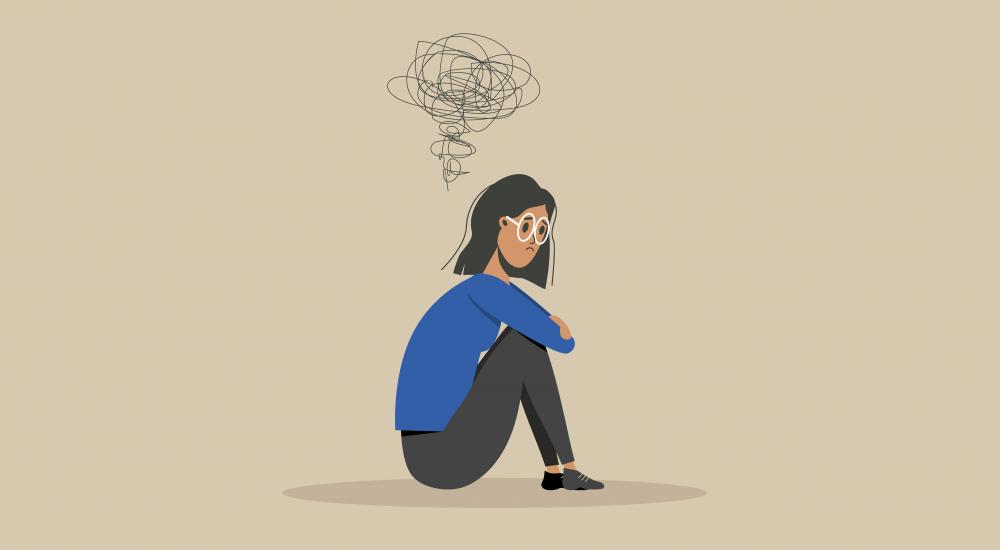Overcoming Burnout to Spark Innovation
In March 2020 as the COVID-19 pandemic emerged, team members from KIC UnivAssist—an organization that partners with more than 300 universities worldwide to support international engagement efforts—were traveling in South America for a series of in-person recruitment activities. When they were suddenly forced to cancel the events, company leaders knew they would have to find new ways of doing business to recoup the revenue loss.
They also realized that guarding employees’ emotional health was paramount.
“Our business [would] only [survive] if our employees were mentally well and felt that we understood their concerns about their families, about whether they’d be able to go back into the office, and about the impact on their jobs,” says KIC UnivAssist cofounder and director Swaraj Nandan, MBA. “So, the first thing that we did was we got the team together and told them that whatever we need to do, we will do it together.”
To help everyone stay focused amid the uncertainties of the first weeks of the pandemic, the team brainstormed and decided on four impact projects—one of which was transforming previously planned in-person college fairs into virtual events. The results were unexpectedly positive: The company, which had offered recruitment activities in about 30 countries prior to the pandemic, expanded its reach to include activities in more than 65 countries. Additionally, the virtual format reduced costs for participating universities while offering them stronger market data, and students were exposed to more diverse higher education options.
“We were surprised [by the results], as our primary focus was to get back to where we were, helping universities connect with the students in those 30-plus countries,” Nandan says. “[Deciding on] four impact projects gave our people a sense of direction and vision. It really drove innovation in our organization.”
Historically, higher education can be slow to change—but even this industry was caught up in the wave of forced innovation brought on by COVID-19. For international education professionals across the globe, the early days of the pandemic compelled quick shifts to new ways of thinking and doing, including reevaluating priorities and workflows.
As the KIC UnivAssist team discovered, many of these were long-overdue changes that brought about positive outcomes. To continue to innovate and move the field forward, international educators need to acknowledge signs of struggle and burnout—and find ways to overcome it. By prioritizing self-care and setting aside time for creative thinking, professionals can better consider new approaches with open minds.
Burnout in the Field
This combination of forced innovation and caring for staff members’ mental health and well-being was successful for Nandan’s team at the beginning of the pandemic. But after a year and a half of adapting to ever-changing circumstances, handling the tyranny of the urgent, and managing the difficulty of planning for anything other than the short term, it’s clear: International educators are exhausted. They are burned out. And when people are depleted, it seems easier to default back to the familiar—and doing so keeps the field from continuing to evolve and innovate.
International educators can start by acknowledging and identifying burnout and related problems, then taking steps to ameliorate them. This process often begins by talking with colleagues experiencing the same issues.
Having these conversations is what Carolyn M. Becker, MSEd, and Maggie Mahoney, MEd, aim to help colleagues do. As co-chairs of Texas International Monthly (TIM), a professional network and organization for education abroad professionals in the Longhorn State, Becker and Mahoney surveyed TIM members to identify topics of interest for discussion at the group’s monthly meetings. “Staff morale and burnout” was by far (68 percent) the issue that TIM members most wanted to explore.
“We’re all in a space of burnout with feelings of lassitude and languishing, and it takes much more to fill our buckets right now than it would normally.” —Maggie Mahoney
“We’re all in a space of burnout with feelings of lassitude and languishing, and it takes much more to fill our buckets right now than it would normally,” says Mahoney, assistant director of learning abroad at the University of Houston.
“As [international education] professionals, it seems as though we are not able to move forward mentally,” adds Becker, director of education abroad at Texas Woman’s University.
The professional fatigue began well before the pandemic. Professionals working in the field already were dealing with the challenges brought on by immigration policies and travel bans put in place by President Donald Trump’s administration, as well as broader global unrest. The global health crisis of COVID-19 added stressors, as each nation put in place their own policies for masking, social gatherings, and vaccines.
“It’s not just the United States for us as international educators—it is the entire world,” says Mahoney. “[We have to track] every single update from every single country or every U.S. Department of State or Centers for Disease Control travel alert that may affect our mobility, our students abroad, or our international partners. Everything happening across the globe does matter to us.”
A Pebble in the Shoe
The cumulative effect of these factors has led many international educators to experience burnout and related mental health issues. The World Health Organization (WHO) defines burnout as “a syndrome conceptualized as resulting from chronic workplace stress that has not been successfully managed.”
“The emphasis on ‘chronic’ means someone is dealing with these job stressors pretty much all the time, every day, as opposed to an occasional crisis or emergency,” says Christina Maslach, PhD, professor emerita of psychology at the University of California-Berkeley, who developed the Maslach Burnout Inventory. “This is the ongoing pebble in your shoe.”
The term “burnout” is often overused to describe a workplace phenomenon that would be more accurately labeled as exhaustion or overextension, Maslach says. WHO identifies three primary dimensions of burnout: energy depletion or exhaustion, cynicism toward and disengagement from one’s job, and feelings of ineffectiveness. While burnout is not a medical condition or mental illness, it can lead to health problems such as stress, anxiety, or depression if it isn’t addressed.
“The emphasis on ‘chronic’ means someone is dealing with these job stressors pretty much all the time, every day, as opposed to an occasional crisis or emergency.” —Christina Maslach
Burnout should not be viewed as a personal problem that calls for self-care strategies such as meditation, exercise, and nutrition.
“Think of the analogy of the canary in the coal mine,” Maslach says. “The bird is sent in cheerful and singing. But if it comes out ill and unable to breathe, we don’t say, ‘What’s wrong with the canary? Why isn’t it strong and tough enough?’ We take it as a signal that the mine is not a safe environment.” In the same way, she explains, job stress or burnout is a sign that something is not going well in the workplace.
Fatigue Factors in International Education
For many international educators, things are not going well in the workplace. Higher education is under tremendous stress as institutions face declining student enrollments, greater competition for fewer high school graduates, and decreased state funding. And the United States, once the top destination for international students, is attracting fewer international students.
Numerous factors contribute to the fatigue experienced by international educators.
Small Staffs
As the designated school official (DSO) and coordinator of international student services at Jefferson State Community College, Stacye Fraser Thompson, MA, is a one-person shop serving 85 international students. And that’s not the only hat she wears: Thompson also is an academic adviser and supports domestic admissions efforts.
“We don’t have all the resources or the level of structure of four-year universities by any stretch of the imagination,” says Fraser Thompson, whose doctoral dissertation will explore the effects of COVID-19 on institutional support for DSOs at community colleges. “So [I’m] having limited resources in trying to help the students navigate what has been a very difficult time, and then I’m still navigating it personally. It’s very stressful.”
Budget Cuts and Layoffs
While numerous sectors of higher education were hit hard financially, many international and study abroad offices were downsized significantly or completely cut since the pandemic began. “International education is a small world,” Becker says. “So not only are we supporting students who may have lost out on their dreams, but we’re also thinking about the emotional onslaught [experienced by] our friends and our colleagues.”
The Need to Prove One’s Worth
During the months that international travel was shut down (and for some, it is still on hiatus), colleagues across campus often perceived that international educators had very little to do. This misconception drives many professionals to work harder in an effort to prove their value.
“‘When are you going back to work?’ was a question I got frequently, even from my family,” Mahoney says. “I’ve been busier than ever over the past year and a half in so many different ways. And for people to assume that I’m doing nothing just adds to the languishing.”
The Mind-Body Connection
With frequent changes in immigration policies, constant shifts in COVID-19 protocols around the world, and other challenges, international educators often forget to pause for self-care. Their resilience is at risk.
“For many of us in international education, one of the reasons why we’re in the field is because we love supporting students to find those global opportunities so they can grow personally and professionally,” says Jane Bjerklie-Barry, director of Saint Anselm College’s Office of International Programs. “But if our health crashes and burns, how can we be of help to anybody else?”
A certified mindfulness meditation teacher, Bjerklie-Barry encourages colleagues to “give yourself the gift of pausing and releasing physical tension and mental fatigue.” That release can be done in a variety of ways, including breathing exercises; physical activity such as walking, swimming, or bike riding; or meditation.
“If our health crashes and burns, how can we be of help to anybody else?” —Jane Bjerklie-Barry
“Our brains function better in terms of creative problem-solving if we give them a chance to rest,” Bjerklie-Barry says. “We are more resilient when our minds and bodies are rested. In our culture, we oftentimes equate resiliency with being tough and being able to just grind it through, but actually nothing could be further from the truth. Resilience is the ability to withstand challenges because we’ve been able to rest our minds and bodies.”
For Sabrina Bahir, MA, director of global enrollment management at the Chicago School of Professional Psychology, the global pandemic lockdown provided an opportunity to rewrite her department’s strategic plan.
“Travel restrictions [spurred by the pandemic] allowed me to dive into areas…that we [previously] didn’t have time for with our small team spread thin when split between office and recruitment trips abroad,” Bahir says.
Anticipating that most students wouldn’t be able to enter the United States, Bahir developed new strategies for U.S.-based recruitment and proposed for her department to oversee and rebuild education agent relationships. She also recommended having her team attend all possible virtual fairs, “even if just for brand awareness and testing the waters with marketing opportunities abroad,” she says.
“I was grateful for the opportunity to present formalized strategies to support [our institution’s] broader global strategic plan and mission,” Bahir says.
The Care and Feeding of International Educators
Even in normal times, strategy and creativity—which often fall to the bottom of the to-do list—must be intentionally nurtured. Given that many international education professionals are feeling depleted, how can they cope with and move through the effects of the pandemic (personally and professionally) to make room for creative thinking? Here are some suggestions from colleagues and experts.
Prioritize.
Becker suggests “dividing tasks into ‘need to do’ and ‘nice to do’ lists.” Think about how priorities have shifted in the face of new demands from students and institutions. Taking stock of the priorities can help narrow the focus for teams and individuals.
Be flexible.
Create an environment where staff feel free to work remotely or take an afternoon off to recharge. Nandan has invited his team members to allow their children to sit on their laps or to show off their pets during Zoom meetings, for example. “We can be vulnerable and [show one another] that all of us are in the same place,” he says.
Implement team-building.
Carve out times for employees to decompress, brainstorm, or just get to know each other. KIC UnivAssist, for example, has volunteer “Happiness Ambassadors” who plan fun, virtual activities for employees each month, such as Bingo Night or an employee talent show.
In a similar spirit, the team of three at University of Mary Washington’s Center for International Education instituted “emergency happy hours with Stella” (as in Stella Artois, the beer) while working remotely. These gatherings convened spontaneously to talk about anything besides work. “It was a time to just disconnect and talk about anything that was not job-related,” says director Jose A. Sainz, PhD, who is also an associate professor of Spanish. “We could just enjoy a drink together and talk about vacation plans, our kids, or just life. Now that we’re on a hybrid schedule, working three days in the office and two days at home, [these meetings have helped us] balance self-care, family time, and professional responsibilities.”
Offer professional development.
Give employees opportunities to grow professionally and take their minds off the global health crisis. Toward that end, Bahir brought together the global enrollment and student support teams on campus for training on intercultural competence, led by experts in that field.
“This is a great opportunity for creating cohesiveness among departments that have to work together in new ways given the challenges of our time,” Bahir says. “We had a third party [help us better] understand the shifting needs of international students and gain insight into cultural components of how they connect with a U.S. institution. And people were appreciative of that space [to forget about] a global crisis and talk about how we connect with other human beings.”
Promote wellness.
Encourage employees to practice good self-care habits such as exercise, meditation, and social connection. In April, KIC UnivAssist hired a wellness consultant to guide team members through these modalities. And each day at 10:00 a.m. and 3:00 p.m., the office plays 5 minutes of meditative music through the intercom so employees can take a moment to stretch, close their eyes, or just think about something besides work.
Reach out to colleagues.
Professional groups such as TIM and NAFSA give international professionals an outlet for sharing ideas, asking questions about best practices, or venting about frustrations. “It’s just lovely to have a group of colleagues to connect with and to feel that solidarity and validation from,” says Becker. “It’s a lot easier to move forward when I realize other people are dealing [with similar issues].”
Forging Ahead
As difficult as the pandemic has been on every level, the global crisis has given higher education—and specifically international education—a golden opportunity to reimagine the future. By recognizing our colleagues’ fatigue and taking steps to move forward, the field can tackle the big-picture questions, such as what international education will look like in a postpandemic landscape, or to what degree mobility is necessary for international experiences. Addressing these big-picture questions starts with taking care of mental health needs and opening minds to creativity and innovation.
“This is a very giving field,” says Bahir. “My priority is having open communication, encouraging self-care practices, and creating space for dialogue about challenges we face and how to navigate them.” •
Additional Resources
About International Educator
International Educator is NAFSA’s flagship publication and has been published continually since 1990. As a record of the association and the field of international education, IE includes articles on a variety of topics, trends, and issues facing NAFSA members and their work.
From in-depth features to interviews with thought leaders and columns tailored to NAFSA’s knowledge communities, IE provides must-read context and analysis to those working around the globe to advance international education and exchange.
About NAFSA
NAFSA: Association of International Educators is the world's largest nonprofit association dedicated to international education and exchange. NAFSA serves the needs of more than 10,000 members and international educators worldwide at more than 3,500 institutions, in over 150 countries.
NAFSA membership provides you with unmatched access to best-in-class programs, critical updates, and resources to professionalize your practice. Members gain unrivaled opportunities to partner with experienced international education leaders.














